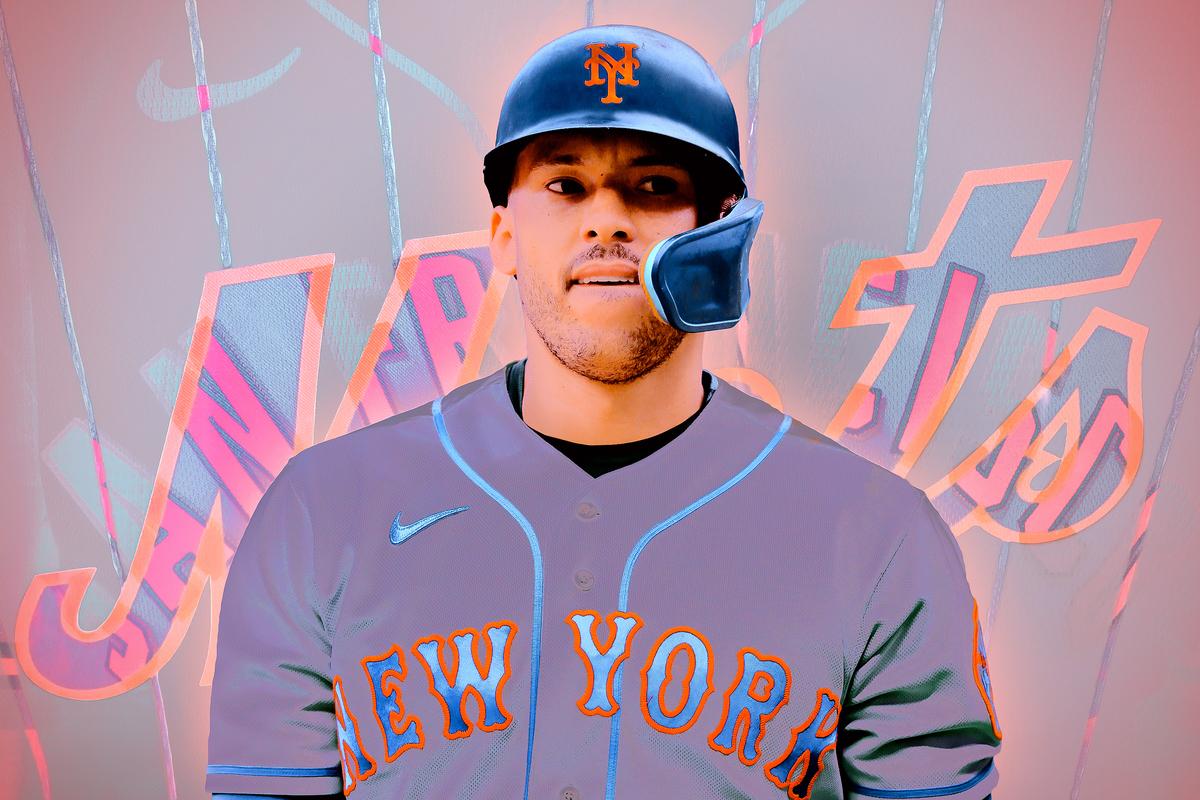
Almost 20 years ago, an Onion headline declared, “Yankees Ensure 2003 Pennant By Signing Every Player in Baseball.” The lede of the story read, “With a week to go before pitchers and catchers report for spring training, the New York Yankees shored up their pitching, hitting, and defense Monday by signing every player in professional baseball.”
Change “a week” to “several weeks” and “Yankees” to “Mets,” and you’ve more or less summed up the offseason of the other team in New York, which is making a bid to be the team. The size of that bid is a bit more than $800 million, the amount Mets owner Steve Cohen has committed to players this winter—not counting the steep penalties he’ll pay for exceeding the spending threshold inserted into the CBA specifically to stop him from flaunting his billions on the field. The latest, greatest, and most pricey of the Mets’ acquisitions is shortstop—scratch that, third baseman—Carlos Correa, who signed with the Mets early Wednesday in a development that might be boringly labeled “a stunning turn of events” but would be better described as “absolutely bonkers.”
New York Post reporter Jon Heyman, who briefly broke the baseball internet earlier in the month by tweeting, deleting, and retracting a report that “Arson [sic] Judge appears headed to the Giants”—a perfect storm of entertaining typo and erroneous revelation—re-seized the spotlight and made up for his flub by breaking the Correa news at 2:38 a.m. Eastern (and then, dramatically, letting that news simmer for almost 20 minutes before offering a clarifying followup). Heyman’s “Arson Judge” oopsie gave Giants fans false hope of landing one marquee free agent; his Correa report dashed their dreams of securing another. Correa, of course, had been signed and sealed but not quite delivered to the Giants, who’d hammered out a 13-year, $350 million financial framework with Correa and agent Scott Boras last week. Correa, who had already changed his Twitter header to a photo of Oracle Park, had been due to be introduced as a Giant on Tuesday, in a press conference that was cryptically and tersely postponed that morning.
Subsequent reporting pointed to a perceived (and still unspecified) problem with Correa’s physical, which seemingly scuttled the deal and gave the Mets the chance to deprive San Francisco of a second superstar who’ll be suiting up in New York next year. (The Giants lost out to the Yankees in the Judge sweepstakes, after offering that giant roughly as much money as they later almost gave Correa.) “I’d say there’s some smoke,” a “Mets person” told The Athletic’s Ken Rosenthal and colleagues last week in reference to the team’s interest in Correa before he’d agreed to terms with the Giants. “I’m not sure how big the fire is, though.” Evidently the fire is frickin’ enormous, burning hot enough to thaw the heart of any Mets fan still tormented by memories of Wilpon-era austerity.
Since being overtaken by the Braves in the NL East and losing to the Padres in the wild-card round, the Mets have signed or re-signed so many stars that the early-December departure of Jacob deGrom, baseball’s best pitcher on a per-inning basis, seems like little more than a footnote. The Mets have signed reigning AL Cy Young Award winner Justin Verlander to replace deGrom, earmarked close to $300 million to retain Brandon Nimmo, Edwin Díaz, and Adam Ottavino, recruited Japanese ace Kodai Senga, and also signed starter José Quintana, catcher Omar Narváez, and reliever David Robertson, in addition to trading for Rays reliever Brooks Raley. Along with the addition of Correa—which Cohen, who was in Hawaii when the deal went down, called the “one more thing” the Mets needed—for $315 million over 12 years (pending a fresh physical, we should probably point out), those moves have amounted to about $812 million in guaranteed salaries, before luxury tax.
The projected payroll of the Mets’ revamped roster has soared to more than $380 million for competitive balance tax purposes. Not since the mid-2000s Yankees, whose payrolls rose even higher after The Onion satirized their spending, has a team outspent its closest payroll rival by such a significant percentage. In terms of raw dollars, the Mets’ lead on the next-highest rollers—the Yankees, natch—is the largest ever, and their payroll easily surpasses even the inflation-adjusted peak of senior-Steinbrenner extravagance. MLB has, on the whole, boasted enviable competitive balance compared to other major American sports leagues, and although the standings have been stratified of late, market size doesn’t dictate destiny or spending. (See: the San Diego Padres.) But Cohen is trying to break the scale, as the other owners feared he would when they pushed for the so-called “Steve Cohen tax” to suppress the spending of the flushest teams. Cohen’s response: “It’s better than a bridge being named after you.”
Forget approaching $400 million after taxes; all told, the tab for the Mets’ roster figures to fall just a shade below half a billion. ESPN’s Jeff Passan called their likely outlay “staggering” before the bump from Correa’s salary. What comes after staggering? Stupefying? Ten teams are slated to spend less on their entire rosters than the Mets will cough up in CBT dollars alone. The Mets could potentially lower their payroll and reduce their overage charges prior to Opening Day by trading some newly expendable players, such as Eduardo Escobar, James McCann, or Carlos Carrasco. If they do, though, it will likely be because the castoffs no longer have places to play, not because Cohen can’t afford them. As he said about signing Correa, “What the heck’s the difference? If you’re going to make the move, make the move.”
Not only will the Mets’ success last season and hype-building spending spree bolster their already robust revenue, but the Mets franchise is worth more than five times that 2023 player-payroll bill—and Cohen’s net worth, according to some sources, is more than six times that of his hometown team. Signing Correa’s checks is another expense that comes with being a multibillionaire, like collecting ultra-expensive sculptures and paintings, paying 10-figure fines stemming from insider trading, and amassing massive quantities of capital to stick it to his haters. Having “fuck you” money means also having Correa cash. And with Correa in the fold, the Mets hardly have a hole. Their style is impetuous; their defense is impregnable; their offense is ferocious.
OK, their defense is less than impregnable, but it’s better now that it includes Correa. To make this signing even more of a flex, the Mets already employed one of baseball’s best shortstops, Francisco Lindor, whom Cohen signed last year to a 10-year, $341 million extension in the first convincing indication that the Wilpon era was over. Now, neither money nor Lindor was an obstacle to inking Correa, who’ll slide to his right to team up with his friend and fellow Puerto Rican native. (The sure-handed Correa has a good glove, but the incumbent has been baseball’s best defensive shortstop.) Correa hasn’t played a professional inning at third, but his arm and athleticism suggest he’ll excel there, even though Statcast says he’s been best on balls to his right.
Correa was arguably the best free agent available, through the lens of a long-term investment. Correa, who turned 28 three months ago and is well on his way to a Hall of Fame–caliber career, is more than a year younger than Trea Turner, almost two years younger than Xander Bogaerts, and almost 2 1/2 years younger than Judge. Since the start of 2020, he’s stayed fairly healthy, and his lack of black ink belies a bat that’s a safe bet to be about 30 percent above the league average. (This offense is ferocious, nearly top to bottom—and the Mets are moving the right-field fence in, too.) It likely won’t be long until the Giants divulge what disturbed them about Correa’s physical, but from afar, he’s a nearly perfect player to build around, Astros sign-stealing stigma aside. And for the second straight offseason—and the second time in this calendar year—Correa, who spent 2022 with the Twins, gave fans something exciting (or deflating) to wake up to by signing with a surprising team at a very early hour.
This sort of audible has happened before: For instance, in December 2003, shortstop Omar Vizquel failed a physical, thwarting a trade that would have sent him from Cleveland to Seattle. The Giants, of all teams, signed him as a free agent the following year. In late 2013, the Orioles backed out of a prospective signing of setup man Grant Balfour because of shoulder-related concerns; Balfour signed with the Rays, pitched poorly, and was released at the start of his second season with the team. Heck, just last year the Mets were on the opposite end of a similar situation, in which they declined to offer a contract to draftee and Boras client Kumar Rocker after seeing something they misliked in his medicals.
But nothing can compare to the intrigue of a player like Correa pivoting under cover of darkness from one team to another with almost no notice. For fans of the Mets, it’s a pre-Christmas miracle. For fans of the Giants, who entered the winter determined to land a face-of-the-franchise-type position player, it’s a devastating development; there’s no Plan C still out there the team could sign to console fans after it missed out on its top two targets. (Even Dansby Swanson signed during the week when Correa was ostensibly spoken for.) For everyone else, it’s tremendous content.
Despite The Onion’s old headline, there’s no such thing as ensuring a pennant or buying a championship; even juggernaut teams can be humbled by the vagaries of the MLB playoffs. Recent splurges notwithstanding, the Mets aren’t an untouchable superteam; losing deGrom, Chris Bassitt, Taijuan Walker, and Seth Lugo, among others, eats into their improvements. Their path to the postseason won’t be easy either: They aren’t running unopposed in the NL East. Before October rolls around, they’ll have their hands full holding off the Braves and Phillies and preserving the health of their talented rotation, which is vulnerable both because of the average age of Verlander, Max Scherzer, Carrasco, and Quintana (37) and because Senga, who’s used to starting once a week, has topped 145 innings only twice in 11 NPB seasons (most recently in 2019). Yet the Mets have made themselves the NL pennant favorite heading into 2023, which is the best a baseball fan can hope for in a sport where fortune always favors the field.
The New York tabloids demanded that the Yankees splurge in Onion-esque fashion this fall—and they obliged by re-signing Judge and Anthony Rizzo and inking Carlos Rodón. In most cities, in most winters, that would make them the big club on campus. In New York this month, they’ve been knocked off the front page. It is, perhaps, symbolic that the Mets signed Correa on the day that the Yankees were scheduled to reintroduce Judge. Cohen’s Mets haven’t yet tasted postseason success, but they’re past the point of being baseball afterthoughts on their own turf, or any other. They’re daring the rest of the sport to keep up.
“If we don’t win [a World Series] in the next three to five years, I’d consider that slightly disappointing,” Cohen said shortly after purchasing the franchise in November 2020. By next November, when the World Series ends, three years will have elapsed since that statement. Clearly, Cohen puts a high price on avoiding disappointment—and on doing his darndest to ensure that other teams’ fans feel it instead.

